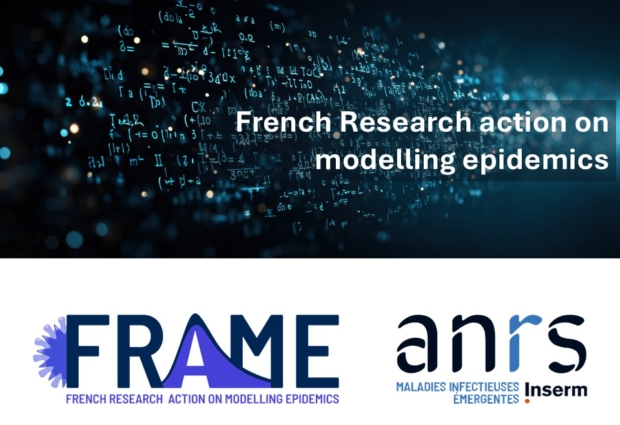
FRAME : French Research action on modelling epidemics
Last updated on 12 November 2025
In brief
- Modelling has become an essential tool for understanding infectious dynamics, at both individual and population levels.
- This French Research action on modelling epidemics covers a wide range of themes focused on the modelling of infectious diseases: population transmission models, emergence and dynamics of epidemics, quantitative epidemiology, within-host models, evolution and phylodynamics, integrating individual behaviours and health economics.
Activities
This network was created at the same time as ANRS MIE, based on a pre-existing SARS-CoV-2 pandemic modelling workgroup, making it part of the ongoing regular interactions between the different French research groups involved in infectious disease modelling.
Its activities aim to develop cutting-edge research based on an expert community, and to encourage the emergence of multidisciplinary collaborative projects that have direct relevance to practice.
Chair and Co-Chair

Simon Cauchemez
Institut Pasteur

Vittoria Colizza
Inserm
Board members
Mathieu Castry
(Inserm)
Florence Débarre
(CNRS)
Sandrine Halfen
(ANRS MIE)
Charly Kengne
(ANRS MIE)
Raphaëlle Métras
(Inserm)
Lulla Opatowski
(UVSQ, Inserm, Institut Pasteur)
Mélanie Prague
(Inria)
Mircea Sofonea
(Montpellier University)
Olivier Supplisson
(Collège de France)
Amandine Véber
(CNRS)
Scientific Committee
Workgroups
- Modelling the epidemiology of sexually transmitted infections (2023-…) – Leader: Samuel Alizon
- Modelling vector-borne and zoonotic diseases (2023-…) – Leaders: Raphaëlle Métras and Simon Cauchemez
- Modelling within-host dynamics (2021-…) – Leaders: Jérémie Guedj and Mélanie Prague
- Accounting for individual behaviours in models of epidemic dynamics (2021-…) – Leaders: Benjamin Roche, Paolo Bosetti and Jocelyn Raude
- Mesoscopic models of epidemic dynamics (2021-2024) – Initiator: Elisabeta Vergu – Leader: Eugenio Valdano
- COVID-19 and respiratory diseases (2020-2022) – Leader: Simon Cauchemez
In addition, discussions have been taking place since 2021 on the COVID-19 experience, and in particular on identifying the changes in organisation and links between crisis management stakeholders that would be necessary to improve the response to emerging diseases. These discussions are coordinated by Pascal Crépey and Harold Noël.
Modelling and COVID-19
To illustrate the broad range of questions central to the activities of the Coordinated Action on Infectious Disease Modelling, here is a series of editorials coordinated by Mircea Sofonea and published in Anaesthesia Critical Care & Pain Medicine in April 2022
- Epidemic models: why and how to use them (Sofonea MT, Cauchemez S, Boëlle PY)
- Modelling COVID-19 in school settings to evaluate prevention and control protocols (Colosi E, Bassignana G, Barrat A, Colizza V)
- Decision-making tools for healthcare structures in times of pandemic (Garaix T, Gaubert S, Josse J, Vayatis N, Véber A)
- Within-host models of SARS-CoV-2: What can it teach us on the biological factors driving virus pathogenesis and transmission? (Prague M, Alexandre M, Thiébaut R, Guedj J)
- Contributions of modelling for the control of COVID-19 nosocomial transmission (Opatowski L, Temime L)
- Challenges for mathematical epidemiological modelling (Crépey P, Noël H, Alizon S)



